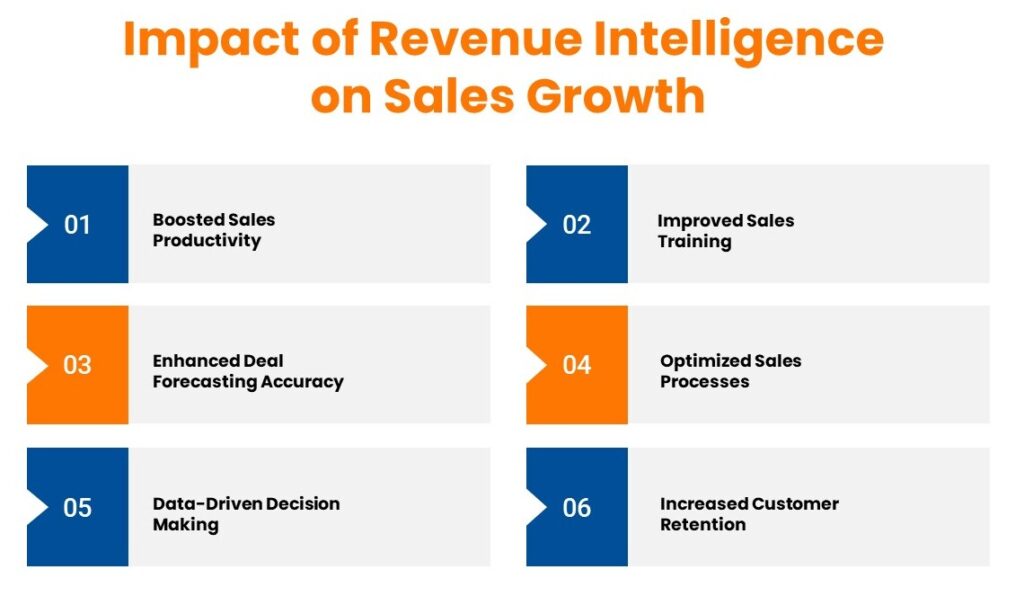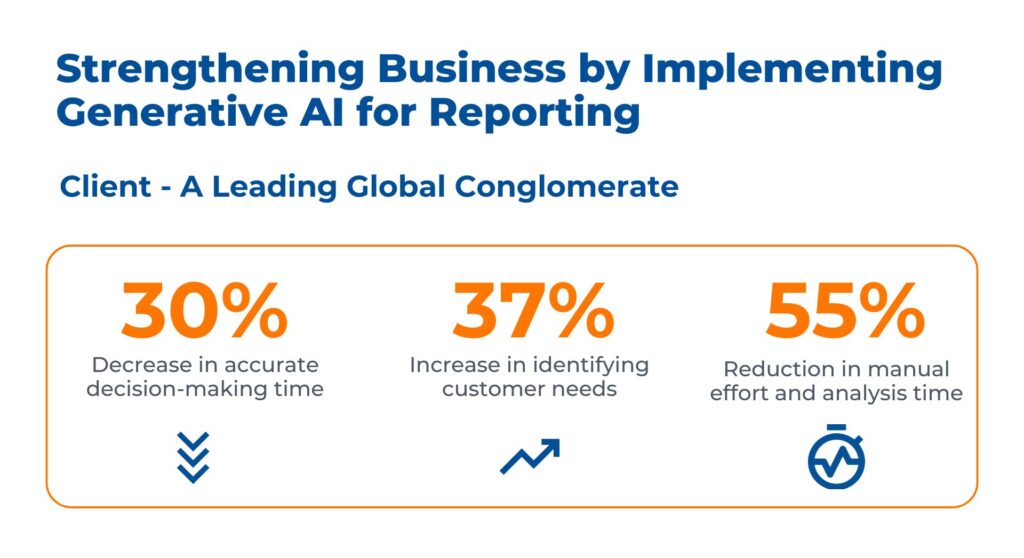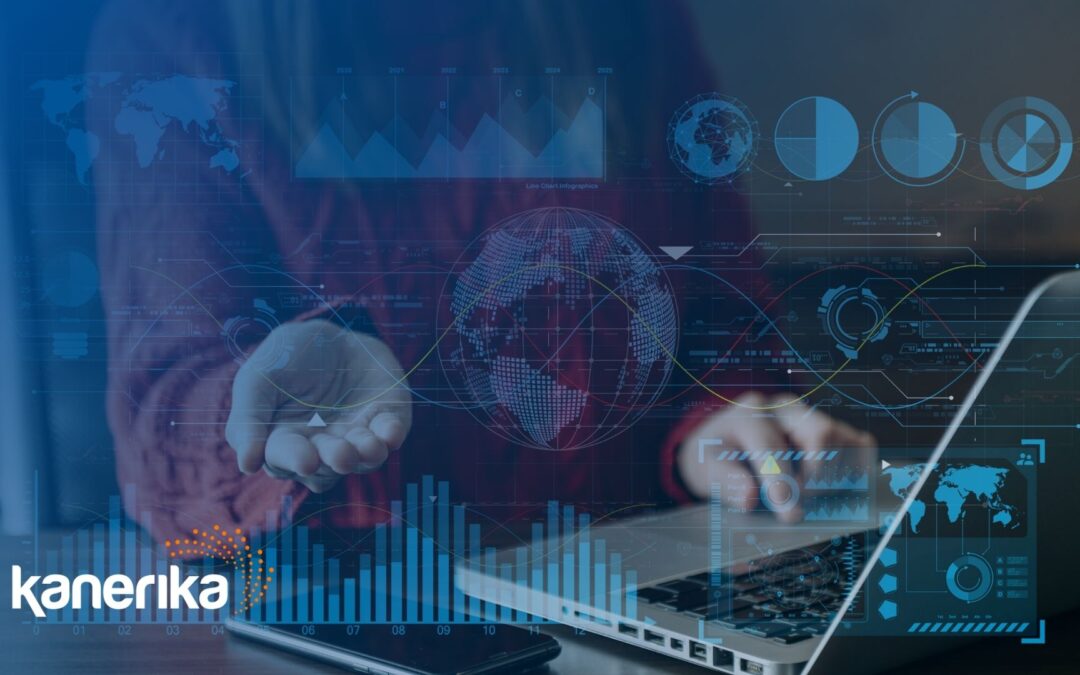Wouldn’t it be great if every sales decision you make could be backed not just by intuition, but by solid, actionable data? What if you could predict the outcome of your sales strategies accurately, enhance team productivity, and significantly boost your revenue? This can be possible with Revenue Intelligence (RI), a new-age approach that leverages artificial intelligence and data analytics to turn every customer interaction into a revenue-generating opportunity.
According to a recent study by Gartner, by 2025, 75% of fast-growing companies will deploy AI-based revenue operations platforms to enhance their sales effectiveness. This number highlights the critical role that Revenue Intelligence plays in modern business strategies, transforming raw data into a strategic asset that not only offers opportunities but also predict challenges before they arise.
Table of Contents
- What is Revenue Intelligence?
- Why Revenue Intelligence is Crucial in Today’s Competitive Market
- Core Components of Revenue Intelligence
- 6 Ways How Revenue Intelligence Can Impact Your Sales
- Implementing Revenue Intelligence: A Step-by-Step Guide
- 7 Top Revenue Intelligence Platforms
- Revenue Intelligence: Use Cases in Sales
- Measuring the ROI of Revenue Intelligence
- Kanerika: Leading the Way in AI-Enhanced Sales Data Analytics
- FAQs
What is Revenue Intelligence?
Revenue intelligence (RI) is an advanced, data-driven approach that improves business revenue strategies by utilizing artificial intelligence and big data analytics. It’s the practice of gathering and analyzing all your customer interaction data, like calls, emails, and website visits. Using AI, RI transforms this data into actionable insights.
It integrates information from various customer touchpoints across sales, marketing, and customer service departments into a cohesive platform. This integration allows companies to gain a comprehensive understanding of their sales processes and customer interactions, leading to more informed decision-making.
RI tools provide actionable insights, forecast sales trends, and identify revenue-generating opportunities, ultimately enabling businesses to optimize their sales strategies and improve overall financial performance in a competitive market environment.
Revenue Intelligence helps you identify exactly what works (and what doesn’t) in your sales pitches, or predict which deals are most likely to close. With RI, you can optimize your sales funnel, close deals faster, and ultimately, boost your revenue.
Why Revenue Intelligence is Crucial in Today’s Competitive Market
Nowadays, with new technology emerging at a rapid speed, traditional sales tactics are no longer effective. Thus, it’s imperative to quickly adapt to these technological improvements if you want to stay ahead of your competition and increase sales performance and revenue.
Revenue intelligence (RI) has the potential to revolutionize sales. It gives companies the ability to use data to improve sales processes, make informed choices, and eventually spur significant growth. Let’s evaluate the importance of revenue intelligence in improving sales operations.
1. Data-driven Sales Strategies
Factors such as budget, seasonality, brand awareness, and other preferences might influence the purchase behaviors of customers. For optimal impact, businesses must tailor their outreach, recognize purchase signals, and comprehend client behavior using a data-driven approach.
Large volumes of data from many sources, including CRM systems, customer interactions, and website activity, can be analyzed with the help of RI tools and insights. Your customer base is clearly depicted by this data, which enables you to customize your sales approach for the best outcomes.
2. Ever-growing Competition
The corporate landscape is getting more and more competitive as new firms enter the market on a regular basis. You need a strategy to set yourself apart from the competition and attract clients if you want to stay ahead of the curve.
Revenue intelligence facilitates the identification of optimal customer profiles, comprehension of rival tactics, and creation of persuasive sales presentations. You may improve your value proposition and establish yourself as the obvious choice for your target market by utilizing data-driven insights.
3. Need for Actionable Insights
Sales data is valuable, but only if it’s translated into actionable insights. RI goes beyond simply collecting data. It utilizes advanced analytics to uncover hidden trends, identify sales roadblocks, and predict future outcomes.
These actionable insights empower your sales team to prioritize leads effectively, close deals faster, and maximize their overall performance.
Case Study: Deploying AI in Predictive Analytics for Enhanced Insurance Operations
See how a fast-growing US-based insurance firm optimized their finance model by implementing AI/ML in predictive analytics to accurately identify market trends, customer behavior, and enhance fraud detection capabilities.
Core Components of Revenue Intelligence
The core components of Revenue Intelligence (RI) encompass several crucial elements that collectively enhance the ability of businesses to optimize their revenue generation strategies. These components include:
1. Data Integration
Revenue Intelligence systems pull data from diverse sources across an organization, including CRM systems, marketing automation tools, customer support interactions, and external market data.
The goal is to create a unified view of all customer interactions and sales activities, ensuring that data silos are eliminated and every piece of data is leveraged for maximum insight.
2. Real-Time Analytics
Real-time data analysis is one of RI’s biggest benefits. This enables companies to respond quickly to shifts in consumer behavior or industry dynamics. Making informed decisions fast is essential to keeping a competitive edge, and real-time data facilitates this process.
3. Predictive Analytics
Sales teams can better anticipate consumer needs, comprehend purchasing patterns, and estimate sales trends by utilizing predictive analytics, which forecasts future events based on historical data patterns. This component of RI is essential for effective sales planning and strategy, as it helps predict outcomes with a high degree of accuracy.
4. AI and Machine Learning
Revenue intelligence systems rely heavily on artificial intelligence (AI) and machine learning techniques. To find trends, generate new ideas, and offer advice, they analyze enormous datasets. As more data is processed by these technologies, they adapt over time, increasing their relevance and accuracy with time.
5. Actionable Insights
The insights provided by RI tools are designed to be actionable. This means they can directly inform sales strategies, marketing campaigns, and customer engagement practices. Insights often include identifying which deals are most likely to close, which customers are at risk of churn, and which prospects should be targeted with specific offers.
6. Collaboration Tools
Collaboration capabilities that improve departmental coordination among sales, marketing, and customer service are frequently included in RI platforms to promote cross-functional alignment and efficiency.
A unified approach to revenue production is fostered by these solutions, which guarantee that data and insights are shared throughout teams.
7. User-Friendly Dashboards
Tools for dashboarding and visualization are essential for condensing complex data into formats that are easy to understand and use. They give stakeholders the ability to quickly and easily make rational choices by giving a concise and clear summary of sales projections, key performance indicators (KPIs), and other important metrics.
6 Ways Revenue Intelligence Can Impact Your Sales
Revenue Intelligence (RI) is a powerful tool that can transform your sales approach and drive business growth. Let’s look at the key benefits RI offers:
1. Boosted Sales Productivity
Stop following false leads. You may concentrate your sales efforts and find high-value clients with the help of RI. With RI’s ability to forecast deal success and analyze client interactions, your team can concentrate on leads that have the best chance of closing. Shorter sales cycles, more closed deals, and ultimately higher total sales productivity are the results of this.
2. Enhanced Deal Forecasting Accuracy
In the context of modern sales, intuition and conjecture have no place. To produce precise deal estimates, RI makes use of sales activity trends and historical data. This enables you to more confidently project future revenue, efficiently allocate resources, and steer clear of unpleasant surprises at the end of the quarter.

3. Improved Sales Training
Revenue intelligence offers insightful information about the performance of individual sales representatives, pointing out areas of strength and potential areas for improvement. You can ensure that your entire sales staff performs at the highest level by customizing training programs to address particular needs based on the identification of strengths and limitations.
4. Optimized Sales Processes
Using RI, you can find obstacles and bottlenecks in your sales process. Through an analysis of data from various funnel phases, you can identify areas that need to be improved. This enables you to get leads from prospect to customer more quickly by streamlining your sales process and getting rid of pointless stages.
5. Data-Driven Decision Making
Revenue intelligence empowers you to make informed decisions based on real data and insights. From pricing strategies to resource allocation, RI provides the information you need to make strategic choices that drive revenue growth.
6. Increased Customer Retention
This approach helps you identify potential customer churn and allows you to take proactive steps to retain valuable clients. By analyzing customer behavior and identifying dissatisfaction signals, you can address customer concerns and foster long-term loyalty.
Case Study: Implementing Generative AI for Enhanced Reporting
Business Context
The client is a leading conglomerate with presence and diversified operations across the electrical, automobile, construction, and FMCG sectors. The traditional manual approach to analyzing vast data was time-consuming and prone to bias. This approach could not effectively capture underlying trends, sentiments, and opportunities. They wanted to leverage AI to enhance reporting, enable agile decision-making, and identify growth opportunities for better business outcomes.
Kanerika helped them achieve their objectives by utilizing advanced technologies like spaCy, scikit-learn, TextBlob, and Tableau. Following are the solutions we offered to redefine their data analytics process:
- Deployed a generative AI for reporting solution using NLP, ML, and sentiment analysis models to process and analyze data.
- Automated data collection and text analysis to extract insights from unstructured sources like market reports and industry analysis.
- Integrated the new platform with structured data sources and provided user-friendly reporting and visual interfaces.

Implementing Revenue Intelligence: A Step-by-Step Guide
Step 1: Understanding the Purpose
Before starting your implementation process, define the objectives that you want to achieve with RI. Are you looking to increase win rates, improve deal forecasting accuracy, or shorten sales cycles? Clearly defined goals will guide your data collection and analysis efforts, ensuring your RI strategy is laser-focused on achieving your desired outcomes.
Step 2: Identify Your Data Sources
RI thrives on data. The key is to identify the right data sources that provide a holistic view of your customer journey. Here are some key areas to consider:
CRM Data: This is the heart of your sales operation, housing valuable information about customer interactions, sales activities, and deal pipelines.
Marketing Automation Data: Marketing automation platforms capture valuable data on customer engagement with email campaigns, website visits, and landing page interactions.
Sales Rep Activity Data: Call recordings, email logs, and meeting notes provide insights into how your sales team interacts with prospects and customers.
Customer Feedback: Surveys, reviews, and support tickets offer valuable insights into customer satisfaction and areas for improvement.
External Market Data: Industry trends, competitor analysis, and economic indicators can provide valuable context for your sales efforts.
Step 3: Select the Right Revenue Intelligence Tools
The market offers a wide range of RI tools. Consider your specific needs, budget, and level of data expertise when choosing the right platform. Some key features to look for include:
Data Integration Capabilities: Ensure the platform can seamlessly integrate with your existing CRM, marketing automation, and other data sources.
Advanced Analytics and Reporting: Look for tools that can generate insightful reports, identify trends, and provide predictive modeling capabilities.
User-Friendly Interface: The platform should be easy to navigate and use for both technical and non-technical users.
Step 4: Establish a Data Governance Framework
Data is only valuable if it’s accurate and reliable. Establish clear data governance policies to ensure data quality and consistency. This includes defining data ownership, access controls, and data cleansing procedures.
Step 5: Build Actionable Dashboards and Reports
Don’t let your data get lost in a sea of numbers. Develop clear and concise dashboards and reports that highlight key metrics and trends. These reports should be easily accessible to your sales team and leadership, allowing them to make data-driven decisions quickly.
Step 6: Develop a Training Program for Your Sales Team
Equipping your sales team with the knowledge to leverage RI effectively is crucial. Develop a training program that familiarizes them with the RI platform, how to interpret the data, and how to apply insights to improve their sales performance.
Step 7: Monitor and Refine Your Strategy
RI is an ongoing process. Continuously monitor your KPIs, track your progress towards your goals, and be prepared to refine your strategy based on the data you collect. As your business evolves and market conditions change, your RI strategy needs to adapt as well.
7 Top Revenue Intelligence Platforms
1. Groove
Best for AI-driven insights, Groove specializes in enhancing revenue-per-employee through advanced automation and interaction management features like conversation intelligence, which helps optimize strategies for closing more deals. It integrates well with platforms like Salesforce, Google Workspace, and Microsoft 365.
2. SalesLoft
Known for its robust tools for revenue enhancement, SalesLoft offers features like Cadence automation, conversion intelligence, and a comprehensive analytics dashboard to streamline sales processes and enhance revenue. It integrates with Salesforce, HubSpot, and other CRM platforms.
3. Chorus.ai
This tool excels in market intelligence by analyzing customer interactions to improve sales outcomes and strategic focus. Key features include call recording, AI insights, and robust integrations with CRM systems like Salesforce and HubSpot.
4. InsightSquared
Best for monitoring real-time revenue intelligence, it provides sales forecasting, analytics dashboards, and the ability to generate custom reports, making it great for teams needing detailed oversight and strategic planning.
5. Gong.io
Renowned for offering complete data visibility, Gong.io captures and analyzes customer interactions to provide actionable insights. Its features help improve sales strategies through enhanced data understanding and management.
6. Salesforce CRM Analytics
As part of the larger Salesforce ecosystem, this tool extends traditional BI capabilities to include sales-specific analytics and AI. It offers detailed pipeline inspection, actionable insights, and integrates seamlessly with Salesforce’s suite of products.
7. Revenue.io
Focused on multichannel sales engagement, Revenue.io excels in capturing data from communications and turning them into actionable insights with features like real-time notifications, sales leaderboards, and opportunity analytics.

Revenue Intelligence: Use Cases in Sales
Revenue Intelligence (RI) isn’t just about collecting data; it’s about transforming that data into actionable insights that drive real results. Here’s how you can leverage RI to supercharge your sales pipeline:
1. Sales Enablement with RI-powered Insights
Identify Ideal Customer Profiles: RI analyzes customer data to reveal common traits of your high-value customers. Use these insights to create targeted buyer personas and refine your ideal customer profile. This allows your sales team to focus their efforts on attracting the right leads.
Develop Data-Driven Messaging: Analyze customer interactions within your RI platform to understand what resonates with your audience. Craft targeted messaging that addresses their specific pain points and highlights the value proposition that matters most to them.
Improve Sales Rep Coaching: Use RI data to identify individual rep strengths and weaknesses. Tailor coaching programs to address specific needs, equip your reps with the right skills to overcome common objections, and elevate their overall performance.
2. Optimizing Opportunity Management with RI
Data-Driven Deal Scoring: RI can analyze historical data and sales activity trends to predict the likelihood of a deal closing. Implement a deal scoring system based on these insights to prioritize your sales pipeline and allocate resources effectively.
Proactive Risk Management: Use RI to identify potential red flags within deals. Analyze customer sentiment, communication patterns, and engagement levels to predict potential risks early on. This allows you to take proactive measures and mitigate potential roadblocks before they derail the deal.
Data-Driven Forecasting: Say goodbye to guesswork. Leverage RI to generate accurate forecasts based on historical data and real-time sales activity. Improved forecasting allows you to manage resources effectively, set realistic goals, and avoid pipeline surprises.
3. Enhancing the Customer Journey with RI
Identify Customer Buying Signals: RI analyzes customer interactions across various touchpoints. Use these insights to identify when a lead is ready to buy and tailor your outreach accordingly. This allows you to move leads through the sales funnel faster and convert them into loyal customers.
Personalized Customer Interactions: RI reveals customer preferences and past interactions. Use this information to personalize your sales approach. Tailor your communications to address specific needs and interests, fostering deeper customer connections and higher conversion rates.
Improve Post-Sales Customer Retention: RI doesn’t end at the sale. Analyze customer sentiment after purchase to identify potential churn risks. These insights allow you to proactively address customer concerns and foster long-term loyalty.

Measuring the ROI of Revenue Intelligence
Measuring the Return on Investment (ROI) of Revenue Intelligence (RI) is essential to justify the investment in these tools and to understand their impact on your business. Here’s how you can calculate and evaluate the ROI of implementing RI:
1. Direct Revenue Impact
Increased Sales: Evaluate the increase in sales attributed to the insights provided by the RI tools. Compare sales figures before and after the implementation of RI to quantify the direct revenue gains.
Reduced Churn: Analyze the reduction in customer churn rates by using RI to identify at-risk customers and proactively addressing their needs. This can be measured by comparing churn rates before and after RI implementation.
2. Improved Sales Efficiency
Time Saved: Calculate the time saved on manual data entry and analysis. With RI automating these processes, sales teams can focus more on selling. Estimate the value of this time saved by considering the average sales per hour of your sales team.
Deal Velocity: Measure the reduction in the sales cycle length. RI can provide insights that help close deals faster. Compare the average deal closing time before and after implementing RI to gauge its efficiency impact.
3. Enhanced Decision-Making Capabilities
Data-Driven Decisions: Assess the quality of decisions made post-RI implementation. This can be done by reviewing the success rate of strategic decisions and initiatives that were influenced by RI insights.
Forecast Accuracy: Measure the improvement in sales forecast accuracy. Accurate forecasts lead to better planning and resource allocation, which can be quantified by comparing forecast accuracy rates before and after RI adoption.
Calculating ROI
To calculate the ROI of RI, use the following formula:
To calculate the ROI of RI, use the following formula:
ROI= (Net Profit from RI / Cost of RI)×100
Steps to Calculate ROI:
Determine the Net Profit from RI:
- Add up the increased revenue from sales and savings from reduced churn.
- Include the value of time saved and other efficiencies gained.
- Subtract any additional costs directly associated with implementing RI (e.g., additional training, integration costs).
Calculate the Cost of RI:
Include the cost of the RI software, implementation costs, training, and any ongoing subscription fees or maintenance costs.
Apply the Formula:
Insert the values into the formula to get the ROI percentage.

Case Study: AI-Driven Prescriptive Analytics for Supply Chain Optimization
Business Context
The client is a leading food manufacturer in the US. Their complex supply chain network made production planning and scheduling challenging. Furthermore, the company’s production strategy relied heavily on demand forecasting, primarily derived from historical sales data.
Kanerika addressed these issues and optimized their productivity and supply chain processes using the best-in class technologies like Azure AI, Power BI, PyTorch, and MS Dynamics 365. Here are the solutions we offered:
- Leveraged AI and machine learning algorithms, factoring in weather and seasonal changes, to improve demand forecasting accuracy and enhance decision-making.
- Implemented AI in production planning to minimize waste, while maximizing revenues.
- Integrated an AI-based demand forecasting engine with the client’s ERP system, enabling seamless real-time decision-making.

Kanerika: Leading the Way in AI-enhanced Sales Data Analytics
Kanerika, a renowned tech consulting company, elevates your sales performance through AI-powered data analytics solutions. With a proven track record of successful projects for reputed clients across diverse industries like insurance, logistics, and finance, Kanerika stands out as a top artificial intelligence company.
Our expertise lies in transforming raw data into actionable insights, enabling businesses to make informed decisions that drive sales growth. By leveraging advanced AI algorithms, we help identify sales trends, forecast market changes, and optimize customer interactions. We offer innovative solutions tailored to meet the unique needs of each client, ensuring maximum impact and efficiency.














